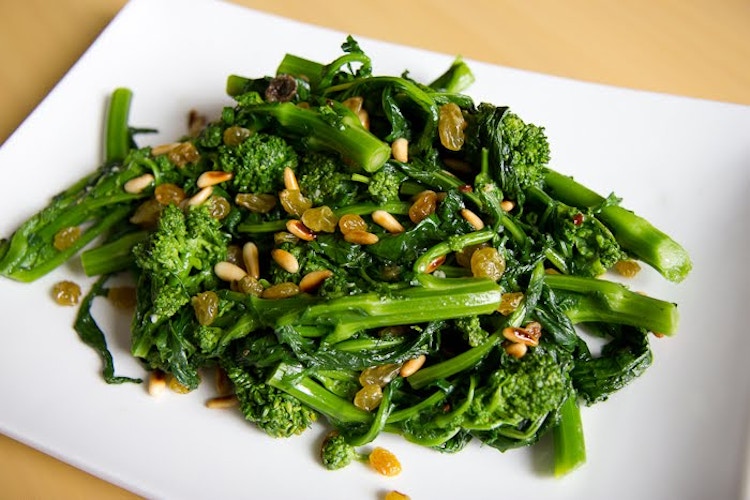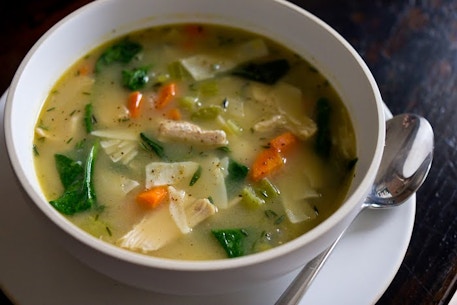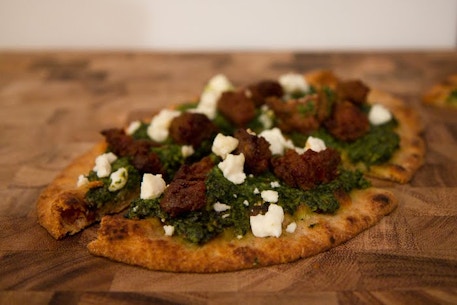Broccoli Rabe Part I
Broccoli rabe is one of those vegetables I didn’t try until I was an adult. Actually, there were a long list of those vegetables: kale, Swiss chard, collard greens, cauliflower, fava beans, sugar snap peas, eggplant, red cabbage, fennel, radicchio, endive, arugula, butternut squash, zucchini, wild mushrooms, parsnips, bok choy, radishes...the list goes on and on. It's not like my family didn't eat vegetables growing up (we did!), it's just that we stuck with a steady all-American rotation of green beans, broccoli, peas, carrots, potatoes, yellow squash, corn, and maybe Brussels sprouts or asparagus on special occasions. I'm sure these were probably the vegetables most readily available at grocery stores in the 1980's and '90's, supplemented by whatever my grandparents happened to be growing in their gardens. As a child, I was pretty ambivalent about vegetables. I didn't hate them, but I certainly didn't love them. They were basically just an obstacle between me and dessert: if I ate the vegetable, I got the dessert. So more or less begrudgingly, I ate the vegetables.
Everything changed in my twenties. Whereas vegetables had previously been an annoyance or an afterthought, as I started cooking more, they gradually became the centerpiece of my diet. Living in France (in Paris, Provence, and Burgundy) over a period of several years definitely changed the way I viewed vegetables. I started shopping at the markets, buying my fresh produce daily instead of weekly–letting the seasons and the colors inspire me. In Provence, I made tians–colorful layered vegetable dishes with eggplants, potatoes, zucchini, tomatoes and fresh herbs (and lots of garlic and olive oil) and beautiful salads of baby greens with steamed haricots verts and heirloom tomatoes with hazelnut vinaigrette. I stuffed zucchini flowers with fresh goat cheese and made hearty winter soups with potatos and leeks.
I learned how to roast vegetables in Burgundy, transforming formerly bland items like cauliflower or sweet potatoes into deeply flavored, caramelized treats. I began experimenting with a host of vegetables I'd never tried before (see: list above) and soon enough, plants were crowding out the meat on my plate. It's not just the colors and flavors and variety of vegetables I've grown to appreciate–it's the way my 31-year old body feels after eating them that I especially love. I feel lighter, healthier, and more energized when I eat a mostly vegetable diet. (But don't worry, I'm not going totally vegan on you all...my husband would never allow that!)

Which brings me back to broccoli rabe. This dark leafy vegetable looks sort of like a lovechild between broccoli and kale, and has a distinctly bitter taste (which I happen to love). It's also packed with antioxidants like Vitamin A and C, and loaded with fiber, calcium, and potassium. I first tried broccoli rabe in Italy sautéed in garlic, olive oil, and a few red pepper flakes, finished with just a squeeze of lemon. So simple and so delicious. Back home I've cooked this dish so many times, though recently I made it Sicilian style, with toasted pine nuts and golden raisins. I love the contrast of the bitter greens with the sweet golden raisins and buttery toasted pine nuts. Sometimes I add a splash of Balsamic vinegar at the end for a little extra complexity. Though you can sauté broccoli rabe raw, I like to blanch it first (a quick boil followed by a dunk ice water) to cut down on its bitterness. Just make sure to drain it well and pat dry before throwing it in the sauté pan.
This broccoli rabe makes a delicious side dish for grilled sausage (or meatballs) with tomato sauce and polenta. For a lighter meal, it's fantastic with grilled salmon, or you can go entirely vegetarian and pair it with roasted squash (butternut, delicata, or spaghetti) and perhaps some farro with wild mushrooms.
Coming up next: Broccoli Rabe Pesto + two recipes
[recipe:best-broccoli-rabe-pine-nuts-golden-raisins-recipe]


